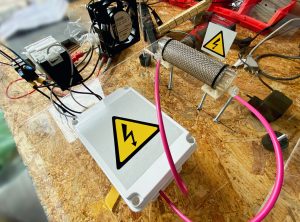Low cost ozone generator developed to eliminate coronavirus in 20 minutes
Chilean engineers look to disinfect spaces with a high exposure to the virus, by means of the controlled ionization of the air.
A group of Faculty and students from Electrical, Mechanical and Metallurgical Engineering from PUC, supported by Infectiology experts, and in collaboration with the Complex Systems Engineering Institute, developed a low cost ozone generator to eliminate virus in critical spaces. The project leader is Vladimir Marianov, Professor at the Electrical Engineering department and Deputy Director of the Complex System Engineering Institute.
This PUC Engineering project is part of the interdisciplinary working commission promoted by the office of the Vice Provost for Research, together with the Medical School, the Innovation center, and other Faculties of the university, through the contribution of new ideas (covid19.ing.puc.cl) to face the peak of the pandemic.

This low cost ozone generator, to disinfect critical areas, seeks to reduce the spread of covid-19.
“Our low cost ozone generator, to disinfect critical areas, seeks to reduce the spread of covid-19, considering that this virus is highly contagious and can remain on surfaces for days”, said Javier Pereda, PUC Professor of Electrical Engineering, who is in charge of technical aspects.
“Hence the idea to use ozone in this cheaper and easier to scale version, because it is a powerful disinfectant, superior to chlorine. In only minutes, it has been proven that eliminates similar virus, like SARS, in up to a 99.99%”, said Pereda. One of our contributions is adding a system that can control the ozone concentration in the space is being treated.
The professor specified that ozone can be generated through a considerable electric field, which transforms oxygen from the air into this gas, which has an intense oxidizing power, capable of deactivate the virus by attacking its membrane.
“We have managed to generate ozone with a low cost equipment, with materials that can be found mostly off the shelf in the country. The system fits in a small box, which connects to an electrical network, managing to disinfect complete spaces in only 20 minutes of operation”, said the specialist.
The team of engineers is about to test this technological solution in reanimation rooms, operating rooms, emergency rooms, ambulances and waiting areas. They also seek to use this technology in public transportation, among other uses.
Ozone
According to the World Health Organization, ozone is the most efficient natural disinfectant against all kinds of microorganisms. In the correct concentrations, this gas achieves an inactivation of 99.99% of pathogens belonging to the same group of the Coronavirus. However, this technology must be used by trained personnel, following strict protocols, as the ozone in high concentrations is toxic. The spaces being treated have to stay closed and without public while disinfected.




 Español
Español
